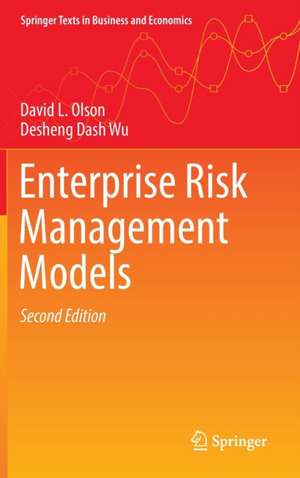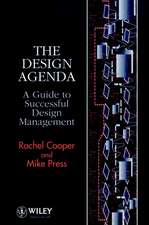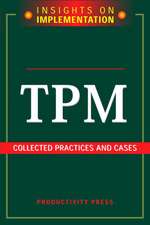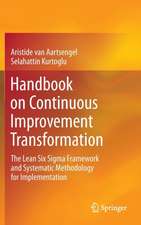Enterprise Risk Management Models: Springer Texts in Business and Economics
Autor David L. Olson, Desheng Dash Wuen Limba Engleză Hardback – 8 ian 2017
This book comes at a time when the world is increasingly challenged by different forms of risk and how to manage them. Events of the 21st Century have made enterprise risk management even more critical. Risks such as suspicions surrounding top-management structures, financial and technology bubbles (especially since 2008), as well as the demonstrated risk from terrorism, such as the 9/11 attack in the U.S. as well as more recent events in France, Belgium, and other locations in Europe, have a tremendous impact on many facets of business. Businesses, in fact, exist to cope with risk in their area of specialization.
| Toate formatele și edițiile | Preț | Express |
|---|---|---|
| Paperback (2) | 580.68 lei 43-57 zile | |
| Springer Berlin, Heidelberg – 15 iul 2018 | 580.68 lei 43-57 zile | |
| Springer – 27 noi 2014 | 728.31 lei 38-44 zile | |
| Hardback (1) | 459.67 lei 22-36 zile | +22.55 lei 6-12 zile |
| Springer – 8 ian 2017 | 459.67 lei 22-36 zile | +22.55 lei 6-12 zile |
Din seria Springer Texts in Business and Economics
- 17%
 Preț: 395.83 lei
Preț: 395.83 lei -
 Preț: 548.25 lei
Preț: 548.25 lei - 17%
 Preț: 490.71 lei
Preț: 490.71 lei - 13%
 Preț: 447.86 lei
Preț: 447.86 lei - 19%
 Preț: 509.83 lei
Preț: 509.83 lei -
 Preț: 360.02 lei
Preț: 360.02 lei -
 Preț: 338.81 lei
Preț: 338.81 lei - 17%
 Preț: 523.87 lei
Preț: 523.87 lei -
 Preț: 374.15 lei
Preț: 374.15 lei -
 Preț: 185.09 lei
Preț: 185.09 lei - 17%
 Preț: 522.65 lei
Preț: 522.65 lei - 19%
 Preț: 465.61 lei
Preț: 465.61 lei - 15%
 Preț: 642.51 lei
Preț: 642.51 lei - 18%
 Preț: 754.79 lei
Preț: 754.79 lei - 19%
 Preț: 534.44 lei
Preț: 534.44 lei -
 Preț: 360.47 lei
Preț: 360.47 lei -
 Preț: 359.93 lei
Preț: 359.93 lei - 17%
 Preț: 363.29 lei
Preț: 363.29 lei - 17%
 Preț: 363.98 lei
Preț: 363.98 lei -
 Preț: 473.41 lei
Preț: 473.41 lei -
 Preț: 361.12 lei
Preț: 361.12 lei - 8%
 Preț: 428.31 lei
Preț: 428.31 lei - 15%
 Preț: 479.55 lei
Preț: 479.55 lei - 13%
 Preț: 490.93 lei
Preț: 490.93 lei - 15%
 Preț: 650.55 lei
Preț: 650.55 lei -
 Preț: 382.19 lei
Preț: 382.19 lei - 15%
 Preț: 562.13 lei
Preț: 562.13 lei -
 Preț: 367.41 lei
Preț: 367.41 lei -
 Preț: 401.79 lei
Preț: 401.79 lei -
 Preț: 361.89 lei
Preț: 361.89 lei - 15%
 Preț: 562.31 lei
Preț: 562.31 lei - 17%
 Preț: 491.52 lei
Preț: 491.52 lei - 20%
 Preț: 819.24 lei
Preț: 819.24 lei - 15%
 Preț: 597.20 lei
Preț: 597.20 lei -
 Preț: 320.05 lei
Preț: 320.05 lei - 20%
 Preț: 694.03 lei
Preț: 694.03 lei - 20%
 Preț: 693.46 lei
Preț: 693.46 lei -
 Preț: 548.53 lei
Preț: 548.53 lei - 17%
 Preț: 366.16 lei
Preț: 366.16 lei - 20%
 Preț: 693.82 lei
Preț: 693.82 lei -
 Preț: 555.90 lei
Preț: 555.90 lei - 9%
 Preț: 766.64 lei
Preț: 766.64 lei
Preț: 459.67 lei
Preț vechi: 553.82 lei
-17% Nou
Puncte Express: 690
Preț estimativ în valută:
87.99€ • 95.60$ • 73.96£
87.99€ • 95.60$ • 73.96£
Carte disponibilă
Livrare economică 31 martie-14 aprilie
Livrare express 15-21 martie pentru 32.54 lei
Preluare comenzi: 021 569.72.76
Specificații
ISBN-13: 9783662537848
ISBN-10: 3662537842
Pagini: 200
Dimensiuni: 155 x 235 x 19 mm
Greutate: 0.5 kg
Ediția:2nd ed. 2017
Editura: Springer
Colecția Springer
Seria Springer Texts in Business and Economics
Locul publicării:Berlin, Heidelberg, Germany
ISBN-10: 3662537842
Pagini: 200
Dimensiuni: 155 x 235 x 19 mm
Greutate: 0.5 kg
Ediția:2nd ed. 2017
Editura: Springer
Colecția Springer
Seria Springer Texts in Business and Economics
Locul publicării:Berlin, Heidelberg, Germany
Descriere
Enterprise
risk
management
has
always
been
important.
However,
the
events
of
the
21st
Century
have
made
it
even
more
critical.
The
top
level
of
business
management
became
suspect
after
scandals
at
ENRON,
WorldCom,
and
other
business
entities.
Financially,
many
firms
experienced
difficulties
from
bubbles.
The
problems
of
interacting
cultures
demonstrated
risk
from
terrorism
as
well,
with
numerous
terrorist
attacks,
to
include
9/11
in
the
U.S.
Risks
can
arise
in
many
facets
of
business.
Businesses
in
fact
exist
to
cope
with
risk
in
their
area
of
specialization.
Financial
risk
management
has
focused
on
banking,
accounting,
and
finance.
We
have
discussed
several
aspects
of
risk,
to
include
information
systems,
disaster
management,
and
supply
chain
perspectives.
The
bulk
of
this
book
is
devoted
to
presenting
a
number
of
operations
research
models
that
have
been
(or
could
be)
applied
to
enterprise
supply
risk
management,
especially
from
the
supply
chain
perspective.
Cuprins
Enterprise
Risk
Management
in
Supply
Chains.-
Risk
Matrices.-
Value-Focused
Supply
Chain
Risk
Analysis.-
Examples
of
Supply
Chain
Decisions
Trading
Off
Criteria.-
Simulation
of
Supply
Chain
Risk.-
Value
at
Risk
Models.-
Chance
Constrained
Models.-
Data
Envelopment
Analysis
in
Enterprise
Risk
Management.-
Balanced
Scorecards
to
Measure
Enterprise
Risk
Performance.-
Information
Systems
Security
Risk.-
Enterprise
Risk
Management
in
Projects.-
Natural
Disaster
Risk
Management.-
Sustainability
Risk
Management.-
Environmental
Damage
and
Risk
Assessment.
Notă biografică
David
L.
Olsonis
the
James
&
H.K.
Stuart
Professor
in
MIS
and
Chancellor’s
Professor
at
the
University
of
Nebraska.
He
has
published
research
in
over
200
refereed
journal
articles,
primarily
on
the
topic
of
multiple
objective
decision-making
and
information
technology.
He
has
authored
over
20
books,
is
co-editor
in
chief
ofInternational
Journal
of
Services
Sciencesand
associate
editor
of
a
number
of
journals.
He
has
made
over
150
presentations
at
international
and
national
conferences
on
research
topics.
He
is
a
member
of
the
Decision
Sciences
Institute,
the
Institute
for
Operations
Research
and
Management
Sciences,
and
the
Multiple
Criteria
Decision
Making
Society.
He
was
a
Lowry
Mays
endowed
Professor
at
Texas
A&M
University
from
1999
to
2001.
He
was
named
the
Raymond
E.
Miles
Distinguished
Scholar
award
for
2002,
and
was
a
James
C.
and
Rhonda
Seacrest
Fellow
from
2005
to
2006.
He
was
named
Best
Enterprise
Information
Systems
Educator
by
IFIP
in
2006.
He
is
a
Fellow
of
the
Decision
Sciences
Institute.
Desheng Dash Wuis a 100-plan Full Professor with the University of Science and Technology of China, Chinese Academy of Sciences, Beijing, China. He has published over 80 papers in refereed journals, such asProduction and Operations Management, Decision Sciences, Risk Analysis, and the IEEE Transactions on Systems, Man, and Cybernetics. He is the editor of the Springer book series entitledComputational Risk Management. His current research interests include enterprise risk management in operations, performance evaluation in the financial industry, and decision sciences. Dr. Wu has served as an Associate Editor/Guest Editor for such journals as theIEEE Transactions on Systems, Man, and Cybernetics, Annals of Operations Research, Computers and Operations Research, the International Journal of Production Economics, andOmega.>
Desheng Dash Wuis a 100-plan Full Professor with the University of Science and Technology of China, Chinese Academy of Sciences, Beijing, China. He has published over 80 papers in refereed journals, such asProduction and Operations Management, Decision Sciences, Risk Analysis, and the IEEE Transactions on Systems, Man, and Cybernetics. He is the editor of the Springer book series entitledComputational Risk Management. His current research interests include enterprise risk management in operations, performance evaluation in the financial industry, and decision sciences. Dr. Wu has served as an Associate Editor/Guest Editor for such journals as theIEEE Transactions on Systems, Man, and Cybernetics, Annals of Operations Research, Computers and Operations Research, the International Journal of Production Economics, andOmega.>
Textul de pe ultima copertă
This
book
is
a
comprehensive
guide
to
several
aspects
of
risk,
including
information
systems,
disaster
management,
supply
chain
and
disaster
management
perspectives.
A
major
portion
of
this
book
is
devoted
to
presenting
a
number
of
operations
research
models
that
have
been
(or
could
be)
applied
to
enterprise
supply
risk
management,
especially
from
the
supply
chain
perspective.
Each
chapter
of
this
book
can
be
used
as
a
unique
module
on
a
different
topics
with
dedicated
examples,
definitions
and
discussion
notes.
This book comes at a time when the world is increasingly challenged by different forms of risk and how to manage them. Events of the 21st Century have made enterprise risk management even more critical. Risks such as suspicions surrounding top-management structures, financial and technology bubbles (especially since 2008), as well as the demonstrated risk from terrorism, such as the 9/11 attack in the U.S. as well as more recent events in France, Belgium, and other locations in Europe, have a tremendous impact on many facets of business. Businesses, in fact, exist to cope with risk in their area of specialization.
This book comes at a time when the world is increasingly challenged by different forms of risk and how to manage them. Events of the 21st Century have made enterprise risk management even more critical. Risks such as suspicions surrounding top-management structures, financial and technology bubbles (especially since 2008), as well as the demonstrated risk from terrorism, such as the 9/11 attack in the U.S. as well as more recent events in France, Belgium, and other locations in Europe, have a tremendous impact on many facets of business. Businesses, in fact, exist to cope with risk in their area of specialization.
Caracteristici
Supports
understanding
the
potential
of
models
within
risk
management
Gives
simple
examples
to
demonstrate
methods
Demonstrates
simulation
and
other
operational
research
models















